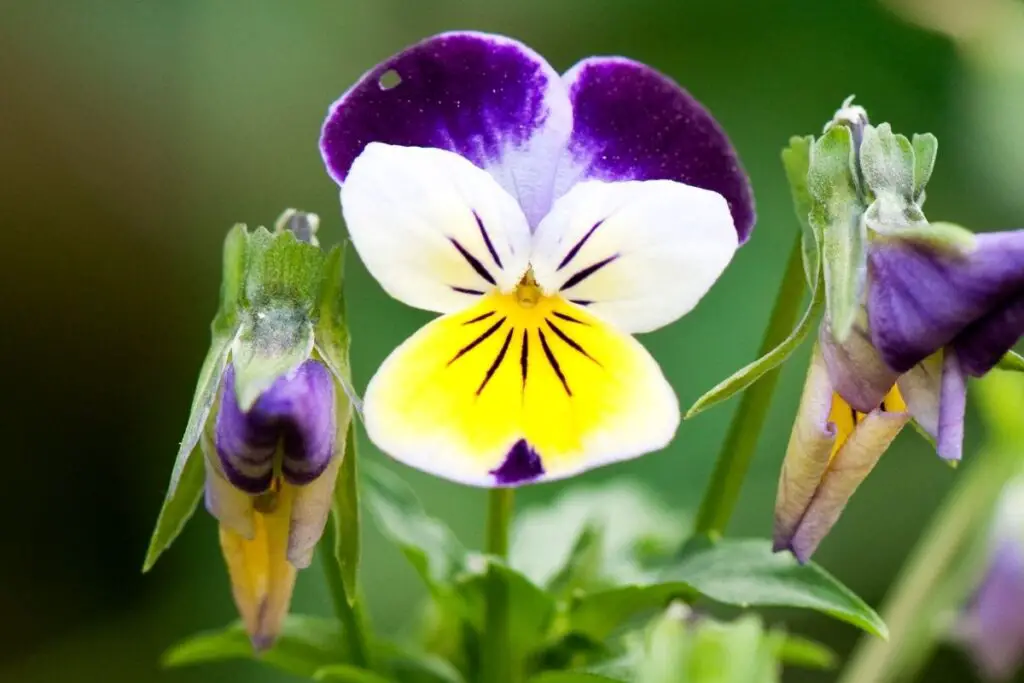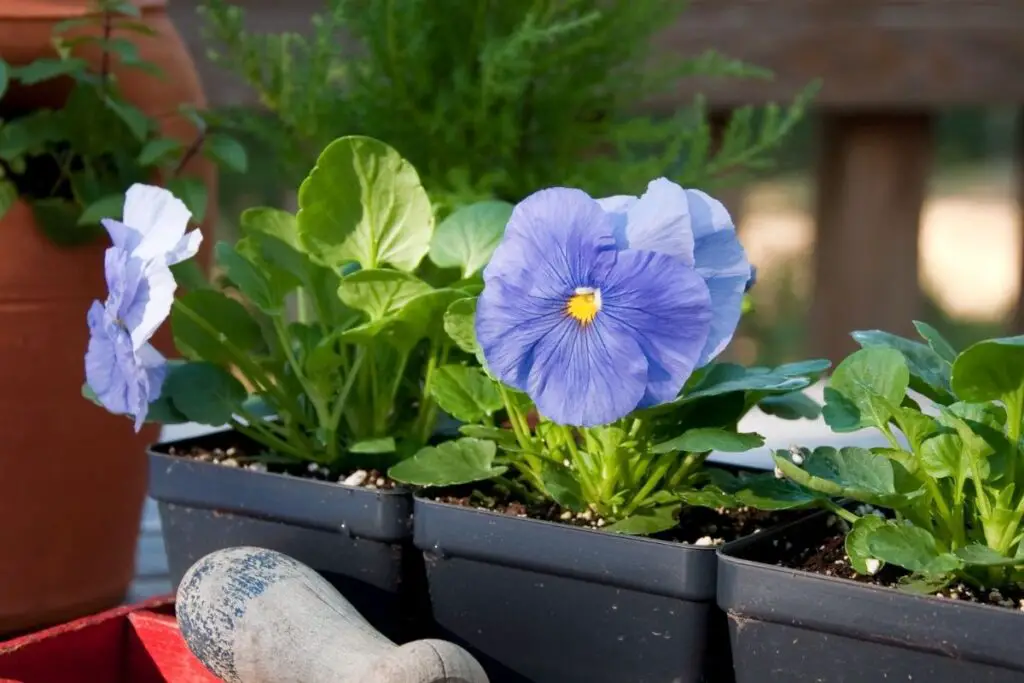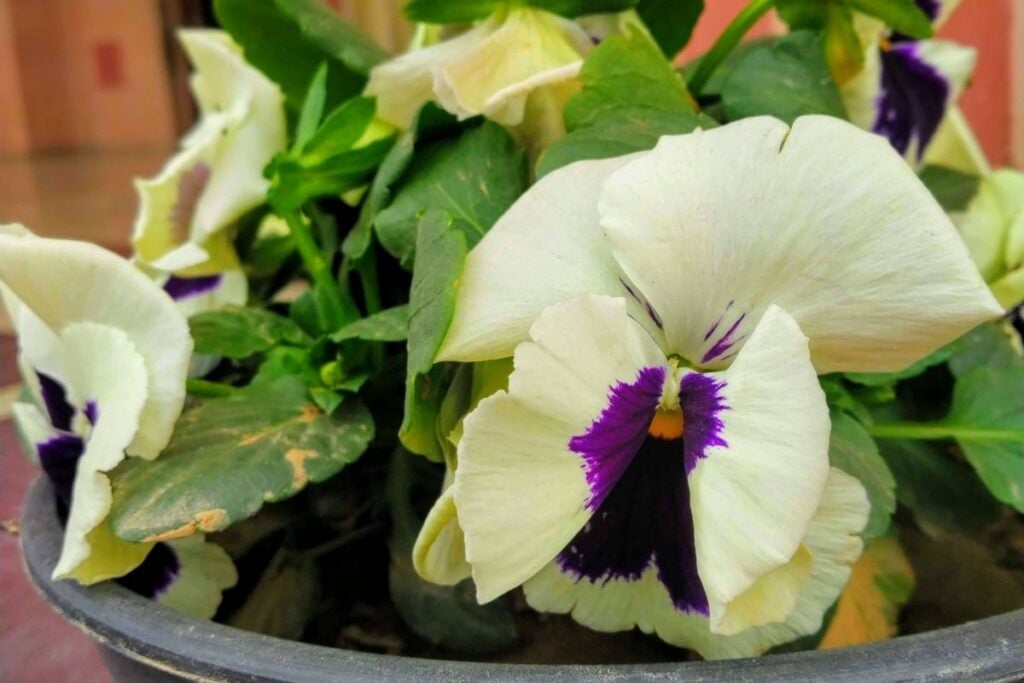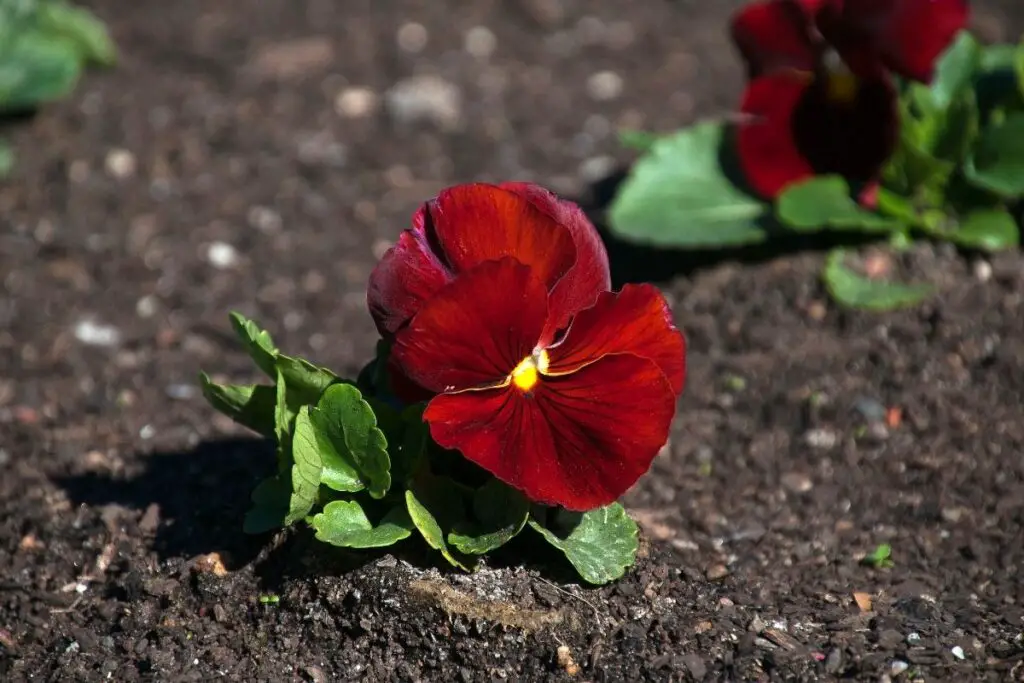Pansy plants are colorful and cheerful blooming flowers. They perform best in cooler weather, and the blooming time of pansies depends on when you are planting.
So, in this article, we shall learn when do pansy bloom and how can we help them bloom last longer.
In general, pansies bloom during the fall and spring just before the weather heats up. Temperatures ranging between 45°F at night and 60°F during the day are best for the pansies to bloom. Pansy plant ceases to bloom when the temperature rises or falls below their optimum levels.
In this article, we will discuss the blooming time of pansies and the care tips to make your pansies bloom more.

The blooming time of pansies
Pansies prefer cool temperatures with a layer of sunshine. They do best during winter in the southern regions, during summer, spring, and fall in the cooler northern regions.
If you plant your pansies in the autumn, they can last for eight months, from September to April or May, and provide colorful blooms in February and March.
Similarly, if you plant your pansies in the spring, it can last up to autumn months, from March to October or November, and it will bloom in August and September.
Do pansies bloom more than once?
It depends on the temperature and climate whether pansies can come back and bloom more than once or not. Pansies have low freeze tolerance, so many of them can die if the winter continues for a long time.
In areas with moderate temperatures, pansies may come again in spring, especially when they were mulched to protect the roots of a plant.
If proper care is taken, pansies will bloom in the fall and then again in the spring, from April to June, until the temperature rises.
Pansies produce more blooms if the temperature is between 45°F at night and 60°F during the day, and it requires special care during winter and summer.
If the temperature goes higher or lower, the blooming capacity of pansies decreases. When the temperature drops in the fall, pansies can bloom again if you prepare them to bloom again in the spring.
If pansies are treated as biennials, they can survive up to two years, and the pansies can bloom more than once.
Also read: Do Pansies Bloom The First Year? (Pansies Blooming Guide)
Climate requirements for pansy blooms
Pansies are cool-climate flowers and they flower during the cooler months of the year such as fall, winter, and spring. However, they prefer temperatures above freezing.
Summer is not the ideal month for witnessing pansy blooms. Pansies do not prefer high temperatures so they tend to dehydrate and die with the rising temperatures.
It doesn’t mean that you can’t grow pansies if you live in a warm region but you need to sow the seeds in the fall.
Whereas in a colder region, consider planting pansies in early spring.
It also depends on the species of pansies. Some pansies are winter pansies and will only bloom in winters. Whereas some are summer pansies, and they will bloom in the summer.
Looking for gardening supplies? We have tested 100's of products before recommending them to you guys. Check out our best pick below:
| Image | Gardening Supplies | Best Price? |
|---|---|---|
 Top
Top Top
Top | Raised Garden Bed Kit | Check On Amazon |
 | XLUX Soil Moisture Meter, Plant Water Monitor, Soil Hygrometer Sensor for Gardening, Farming, Indoor and Outdoor Plants, No Batteries Required | No Results |
 Top
Top Top
Top | 82 Pcs Garden Tools Set and Extra Succulent Tools Set | Check On Amazon |
 | Joeys Garden Expandable Garden Hose with 8 Function Hose Nozzle, Lightweight Anti-Kink Flexible Garden Hoses, Extra Strength Fabric with Double Latex Core, (50 FT, Black) | No Results |
 Top
Top Top
Top | Dual Chamber Compost Tumbler | Check On Amazon |
 Top
Top Top
Top | Sunnyglade Plant Stakes | Check On Amazon |
 Top
Top Top
Top | Organic Cold Pressed Neem Seed Oil | Check On Amazon |
 Top
Top Top
Top | Mighty Mint Gallon :-Insect and Pest Control Peppermint Oil | Check On Amazon |
 Top
Top Top
Top | Scotts DiseaseEx Lawn Fungicide | Check On Amazon |
 Top
Top Top
Top | Jacks Classic 20-20-20 All Purpose Fertilizer | Check On Amazon |
 Top
Top Top
Top | 30,000 Seeds Pollinator Attracting Wildflower Mixture | Check On Amazon |
 Top
Top Top
Top | Survival Vegetable Seeds Garden Kit-Over 16,000 Seeds | Check On Amazon |
How long does pansy bloom last?

Pansies can be both annuals and biennials. If your pansies are treated as biennial plants, they can provide colorful blooms for two straight years.
Once the two-year cycle is complete, pansies die back completely.
Some pansies are annual and can last up to eight months or one year if planted in the autumn, from September to April or May, providing colorful blooms for much of that time.
The length of a pansy bloom depends mainly on temperature, but there are various steps you can maintain to extend the blooming period.
Also read: Are Pansies Perennials? (+How To Grow Pansy As Penerrials)
Do pansies bloom in summer or winter?
Pansies can bloom in both summer and winter, depending on when you are planting.
Pansy blooming season is from spring to summer in cool climates, and when the temperatures rise, pansies die back completely.
And in hot areas, the pansy blooms in fall to winter.
Do pansies bloom all summer?
Pansies are cool-weather flowers, which are mostly treated as annual plants. In some warmer and moderate climates, gardeners can grow pansies throughout the year.
But in areas where the weather conditions are extreme with the seasons, pansies should be grown in the cooler areas.
As pansies prefer cold weather, they generally do not want to bloom in warmer climates. If you reside in a cooler climate zone, you should put your annual pansies in beds or containers in the early spring.
Pansies will bloom until the extreme heat of summer hits the ground.
Due to heat, pansies wilt and bend, and stop producing flowers. But you should continue to take care of your pansies as you will get blooms again in the autumn when the temperatures cool off again.
Also read: How To Keep Pansies Alive In Summer?
How to make pansies bloom in the summer?

There are some varieties of pansies that can tolerate heat and high temperatures. But if the temperatures go over 70°F (21°C) in the summer, even the heat-tolerant pansies can struggle and wilt a little.
To get blooms during summertime:
- Provide them partial shade.
- Water your pansies on time to maintain the growth and blooming rate.
- Mulch the soil bed to prevent excessive evaporation.
- Fertilize them lightly.
- Deadhead throughout the hot months.
If you live in an area with a cooler climate, even in the warmest temperatures of the year, summer will be the best time to grow pansies, and you will get blooms even in the summer season.
But if you reside in a warmer zone, winter will be the best time to plant pansies.
Do pansies bloom all winter?
Pansies are cold-tolerant plants and are often seen blooming even in low temperatures. In some areas with moderate climates, pansies continue to grow throughout the spring with full flowers.
Pansies need light and warmth to develop healthy roots for helping them bloom throughout the winter.
If pansies are planted slightly in warm weather between March and April, there is a good chance that pansies will bloom in winter and last for longer.
The winter bloom depends upon the weather, light, location, temperature of shelter, and soil conditions.
In case of prolonged hours of freezing temperatures, pansies will not be able to get nutrients and water from the soil due to the freeze and thus you will notice slow growth with no blooms.
But this doesn’t mean that they will die. With proper care, your pansies can survive winter and when the temperatures rise above freezing, you will also notice blooms.
How to make pansies bloom throughout the winter?
These tips will help your pansies bloom throughout the winter.
- After watering, make sure that the soil bed doesn’t stay soggy for a longer period.
- Pansies will need at least four hours of direct sunlight during colder months.
- To encourage the pansies to bloom, you need to spread at least 2-3 inches of mulch over the soil surface.
- Prune all the old and dead blooms and other parts of pansies to encourage more blooms in winter.
- When the temperatures go below 10°C, consider covering the pansies. This will protect them from damage.
- You can fertilize the pansies with a liquid fertilizer that they can easily absorb during winter.
Also read: Can Pansy Survive Winter? (Ideal Temperature+Care)
How to make pansies bloom again in the next season?

If you want your pansies to bloom again, keep the following points in mind.
1. Pinch off seed pods to help them bloom again.
Pansy seeds will grow in the long fall and remain dormant until next spring. You need to remove the seed pods before the seeds develop fully.
You can remove them by pinching off the seed pods from the pansies.
Also read: Do Pansy Seeds Need Stratification? (+How To)
2. Remove dead blooms regularly.
Check your pansies twice a week regularly for any blooms that have died.
Remove damaged and diseased blooms to encourage the plant to put its energy towards new blooms and growth.
You should also remove the leggy stems of your pansies because these will not produce any blooms. Make sure you don’t accidentally remove new flowers or blooms.
3. Keep the soil moist and apply phosphorus fertilizer.
Water your pansies to keep the soil moist but avoid overwatering.
Mulch your pansies to keep the soil moist for a more extended period.
Try to apply a liquid phosphorus fertilizer to the plant. You should avoid fertilizers that are rich in nitrogen as they can reduce the blooming of a plant.
Also read: Do Pansies Need Fertilizer? (What Type, How Much & More)
4. Shift your pansies to a new location.
The ideal place for your pansies should be a cool, bright, moist, disease-free, and protected garden area.
Shift or move your pansies to a location that has enough sunlight.
Pansies face many problems in an area with heavy rain and wind, and you should provide them a shield or cover to protect them from such conditions.
Also read: Where To Plant Pansies? (Best Place+Things To Keep In Mind)
5. Protect them against pests and insects.
The most common pests that attack the pansies are caterpillars, snails, slugs, aphids, critters. These insects eat the healthy portions of the plant and do not allow the pansies to bloom.
You can handpick these critters and drop them in a bucket of soapy water. Wash your pansies several times in 2 or 3 weeks and apply an approved pesticide.
Also read: How To Get Rid Of Pests On Pansies? (Bugs Identification+Solution)
Final words
The blooming of pansies depends on when you are planting them. If you plant your pansies in the fall, they will bloom in the spring and vice versa.
Pansies can bloom for up to one or two years. Pansies can bloom more than once if the area has short freezes, cool summers, and moderate temperatures. Plant your pansy seedlings when the soil temperatures are between 45°F and 65°F to get healthy blooms.
Pansies generally don’t bloom much in the summer season, so they require special care. As pansies are cold-tolerant plants, they often bloom throughout winter.
Pansies can bloom more than once if factors like watering, pruning, fertilization are taken care of properly. Also, protect them from pests and insects.
Ref: The University of Arkansas, Britannica, Utah State University, Wikipedia, The University of Georgia, The Pennsylvania State University, The Royal Horticultural Society.
